
Artifact
Browse an alphabetical list of artifacts from the Holocaust and World War II. Each object tells a story about the history and demonstrates human experiences during the time period.
<< Previous | Displaying results 51-75 of 232 for "Artifact" | Next >>
-
Children's art: "Lav Fritz," handmade pamphlet of drawings by Fritz Friedmann
ArtifactAlice Goldberger (1897-1986) was born in Berlin, Germany. Trained as a youth-work instructor, she ran a shelter for disadvantaged children and their families. When Hitler came to power, Alice, who was Jewish, had to give up her post. She immigrated to England in 1939. When war broke out, Alice was interned on the Isle of Man as an enemy alien. While there, she organized a children's facility. Hearing of Alice's work in the camp, psychoanalyst Anna Freud (daughter of Sigmund Freud) intervened to secure…
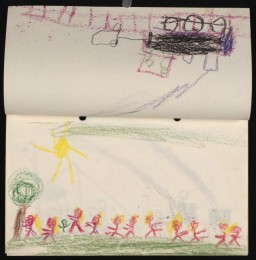
-
Children's art: Lingfield House diary
ArtifactAlice Goldberger (1897-1986) was born in Berlin, Germany. Trained as a youth-work instructor, she ran a shelter for disadvantaged children and their families. When Hitler came to power, Alice, who was Jewish, had to give up her post. She immigrated to England in 1939. When war broke out, Alice was interned on the Isle of Man as an enemy alien. While there, she organized a children's facility. Hearing of Alice's work in the camp, psychoanalyst Anna Freud (daughter of Sigmund Freud) intervened to secure…

-
Child's Sweater Worn in Hiding
ArtifactDuring the 1943 liquidation of the Lvov ghetto, dozens of Jews fled into the city sewers to escape death. Eight-year-old Krystyna Chiger (later Kristine Keren) hid with her family and 16 others beneath the city's streets for 14 months, during which she wore this sweater.

-
Comb made by Yona Wygocka Dickmann
ArtifactYona Wygocka Dickmann fashioned this aluminum comb from airplane parts after the SS transferred her from Auschwitz to forced labor in an airplane factory in Freiburg, Germany, in November 1944. She used the comb as her hair, shaven in Auschwitz, began to grow back.
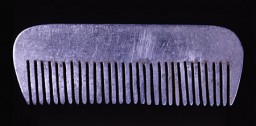
-
Contact print booklets
ArtifactTwo of Julien Bryan's Nazi Germany 1937 contact print booklets of still photographs organized by camera roll. Bryan used these prints to select and crop images for publication or distribution and annotated the covers.
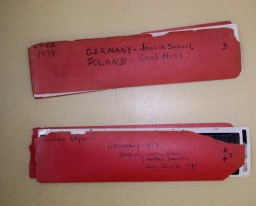
-
Courtroom Sketch of Elie Wiesel at the Trial of Klaus Barbie
ArtifactCourtroom sketch by artist David Rose of Nobel laureate and Holocaust survivor Elie Wiesel on the witness stand at the trial of Klaus Barbie. During his testimony, Wiesel stated that "The killer kills twice. First, by killing, and then by trying to wipe out the traces." June 2, 1987.
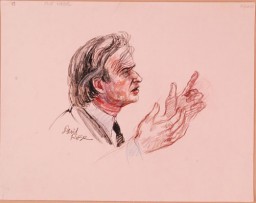
-
Cover, International Military Tribunal program
ArtifactCover of a mimeographed program booklet distributed at the International Military Tribunal at Nuremberg.
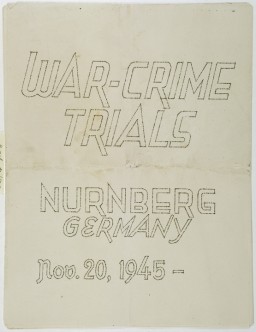
-
Cover of a Japanese-German phrase book
ArtifactGerman Jewish refugees purchased this Japanese-German phrase book shortly after their arrival in Japan. Japan, 1940-1941. [From the USHMM special exhibition Flight and Rescue.]

-
Cover of Stanislava Roztropowicz's diary
ArtifactStanislava Roztropowicz kept a diary from 1943-1944. In it, she describes her family's decision to hide an abandoned Jewish girl, Sabina Heller (Kagan). Sabina Kagan was an infant when SS mobile killing squads began rounding up Jews in her Polish village of Radziwillow in 1942. Her parents persuaded a local policeman to hide the family. The policeman, however, soon asked the Kagans to leave but agreed to hide baby Sabina. Her parents were captured and killed. Sabina was concealed in a dark basement,…
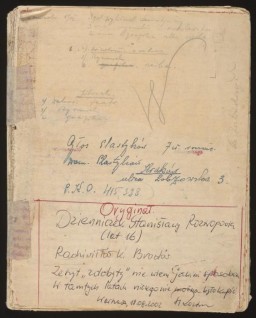
-
Dachau trial mess card
ArtifactEntry pass to a US military dining hall at Dachau, Germany. This card was issued to Anton Litwin, a member of the War Crimes Branch.
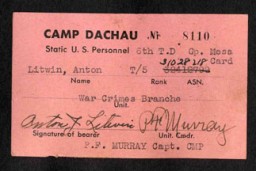
-

-
Dedication to a set of scrapbooks documenting the German occupation of Denmark
ArtifactDedication to a set of scrapbooks compiled by Bjorn Sibbern, a Danish policeman and resistance member, documenting the German occupation of Denmark. Bjorn's wife Tove was also active in the Danish resistance. After World War II, Bjorn and Tove moved to Canada and later settled in California, where Bjorn compiled five scrapbooks dedicated to the Sibbern's daughter, Lisa. The books are fully annotated in English and contain photographs, documents and three-dimensional artifacts documenting all aspects of the…
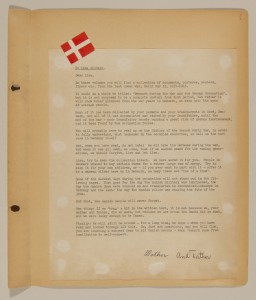
-
Der Stuermer, number 29, July 1934
ArtifactNazi Germany’s semi-official and fiercely antisemitic newspaper Der Stuermer warned of a Jewish program for world domination in this 1934 issue. The article—titled “Who is the Enemy?”—blamed Jews for destroying social order and claimed that Jews wanted war, while the rest of the world wanted peace. Der Stuermer, July 1934.
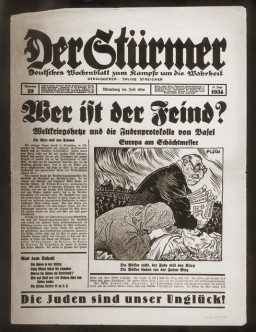
-
Desecrated Torah scrolls
ArtifactThese Torah scrolls, one from a synagogue in Vienna and the other from Marburg, were desecrated during Kristallnacht (the "Night of Broken Glass"), the violent anti-Jewish pogrom of November 9 and 10, 1938. The pogrom occurred throughout Germany, which by then included both Austria and the Sudetenland region of Czechoslovakia. The scrolls pictured here were retrieved by German individuals and safeguarded until after the war.
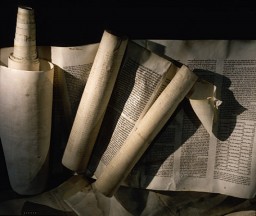
-
Doll from the Krakow ghetto
ArtifactZofia Burowska (Chorowicz) donated this doll, which dates from the 1930s, to the United States Holocaust Memorial Museum. Zofia's parents gave her the doll before the war and she kept it with her in the Wolbrum and Krakow ghettos, Poland. The doll and some of her family's other belongings were left with non-Jewish friends for safekeeping. Zofia was deported to a forced-labor camp for Jews near Krakow, to the Skarzysko-Kamienna camp (also in Poland), and then to the Buchenwald concentration camp in Germany,…
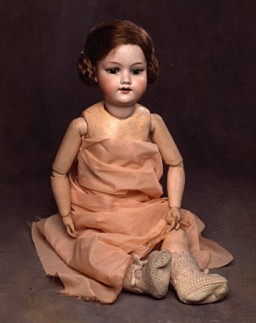
-
Drawing of shoes by a Jewish teenager in hiding
ArtifactJewish teenager Ava Hegedish drew this poignant picture of her mother's well-worn shoes while in hiding. It was drawn while Ava was in hiding at a farm near Belgrade, Yugoslavia (now Serbia), between 1941 and 1944. Once Nazi Germany and its Axis partners partitioned Yugoslavia and Belgrade fell under German control, Ava’s father thought the family’s best chance of survival was to separate and go into hiding. Ava ended up at a farm with some extended-family Serbian relatives. Because she…
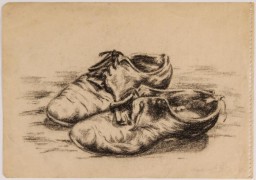
-
Drawing of the SS Patria
ArtifactDrawing of the SS Patria, part of the illustrated diary of Egon Weiss which he compiled during and immediately after his detention in the Atlit internment camp.
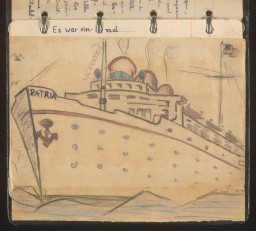
-
Dress Worn by a Child in Hiding
ArtifactA child's dress embroidered with red and blue flowers with small green leaves. This dress was hand embroidered by Lola Kaufman's mother in the Czortkow ghetto. Lola (born Lea Rein) wore this dress when she went into hiding. Lola was hidden first under a bed in the house of the woman who used to deliver milk to the family, then in a dugout under a cellar of a barn where she joined three other Jews in hiding. In March 1944, the Soviets liberated the area. The hidden Jews left their hideout in the middle of…
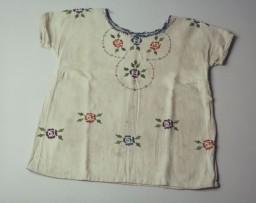
-
Dress Worn by a Hidden Child
ArtifactA blue and white child's dress worn by Sabina Kagan while living in hiding with the Roztropowicz family in Radziwillow, Poland, during World War II. Her rescuers used doll's clothing to make this dress. Sabina was just an infant when SS mobile killing squads began rounding up Jews in the Polish village of Radziwillow in 1942. Her parents persuaded a local policeman to hide the family. The policeman, however, soon asked the Kagans to leave but agreed to hide baby Sabina. Her parents were captured and…

-
Edward Vebell courtroom sketch
ArtifactCourtroom sketch drawn during the International Military Tribunal by American artist Edward Vebell. The drawing's title is "Spectators at War Criminals Trial, Nuremberg, Germany." 1945.
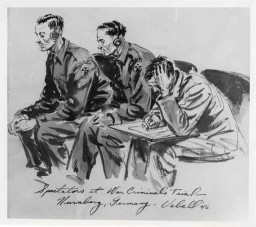
-
Edward Vebell courtroom sketch
ArtifactCourtroom sketch drawn during the International Military Tribunal by American artist Edward Vebell. The drawing's title is "British Courier for the Correspondents." 1945.

-
Edward Vebell courtroom sketch
ArtifactCourtroom sketch drawn during the International Military Tribunal by American artist Edward Vebell. The drawing's title is "German defense counsel -- they are immediately in front of the defendants." 1945.

-
Edward Vebell courtroom sketch
ArtifactCourtroom sketch drawn during the International Military Tribunal by American artist Edward Vebell. The drawing depicts defendants Rudolf Hess and Wilhelm Keitel, with this accompanying text: "Hess looked very hollow cheeked and thin necked. He seemed to ignore the proceedings and kept his head down, absorbed in a book. Keitel tried to retain a rigid military bearing and strike haughty poses." Nuremberg, Germany, 1945.
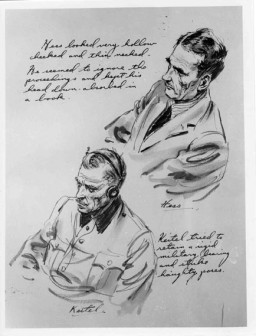
-
Edward Vebell courtroom sketch
ArtifactCourtroom sketch drawn during the International Military Tribunal by American artist Edward Vebell. The drawing's title is "A few studies of the German defense counsel." 1945.
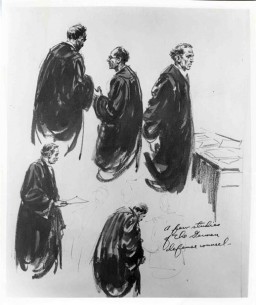
-
Eichmann trial ticket
ArtifactSingle-use entry pass for the trial of Adolf Eichmann in Jerusalem, Israel. June 8, 1961.
